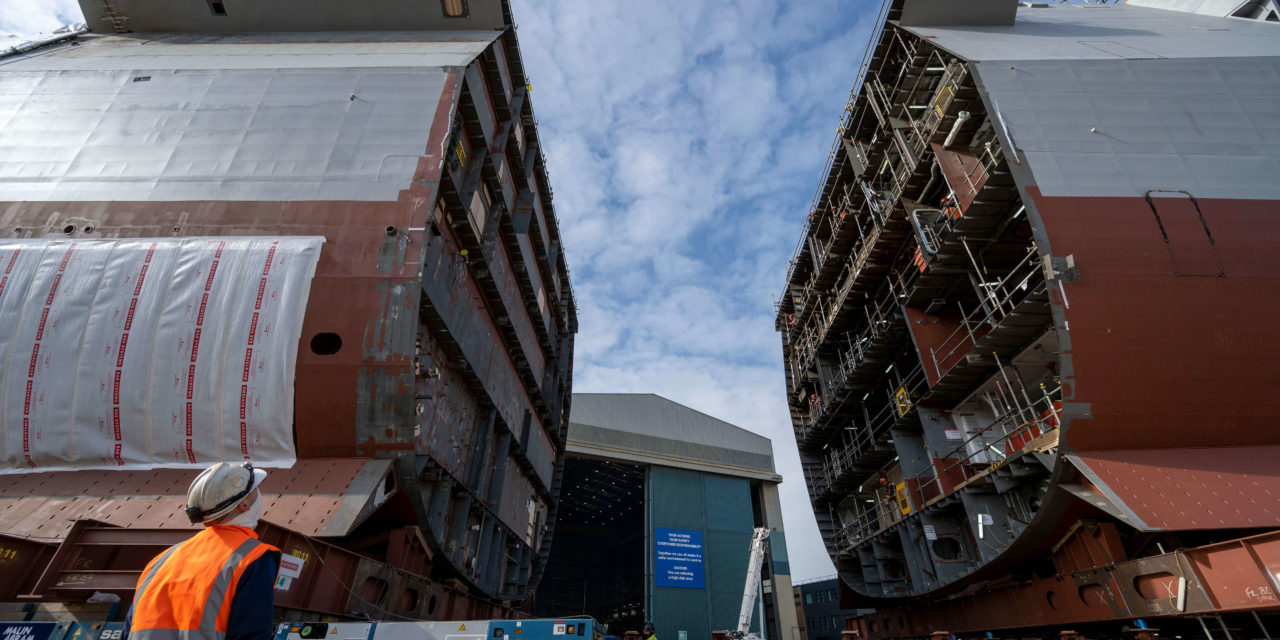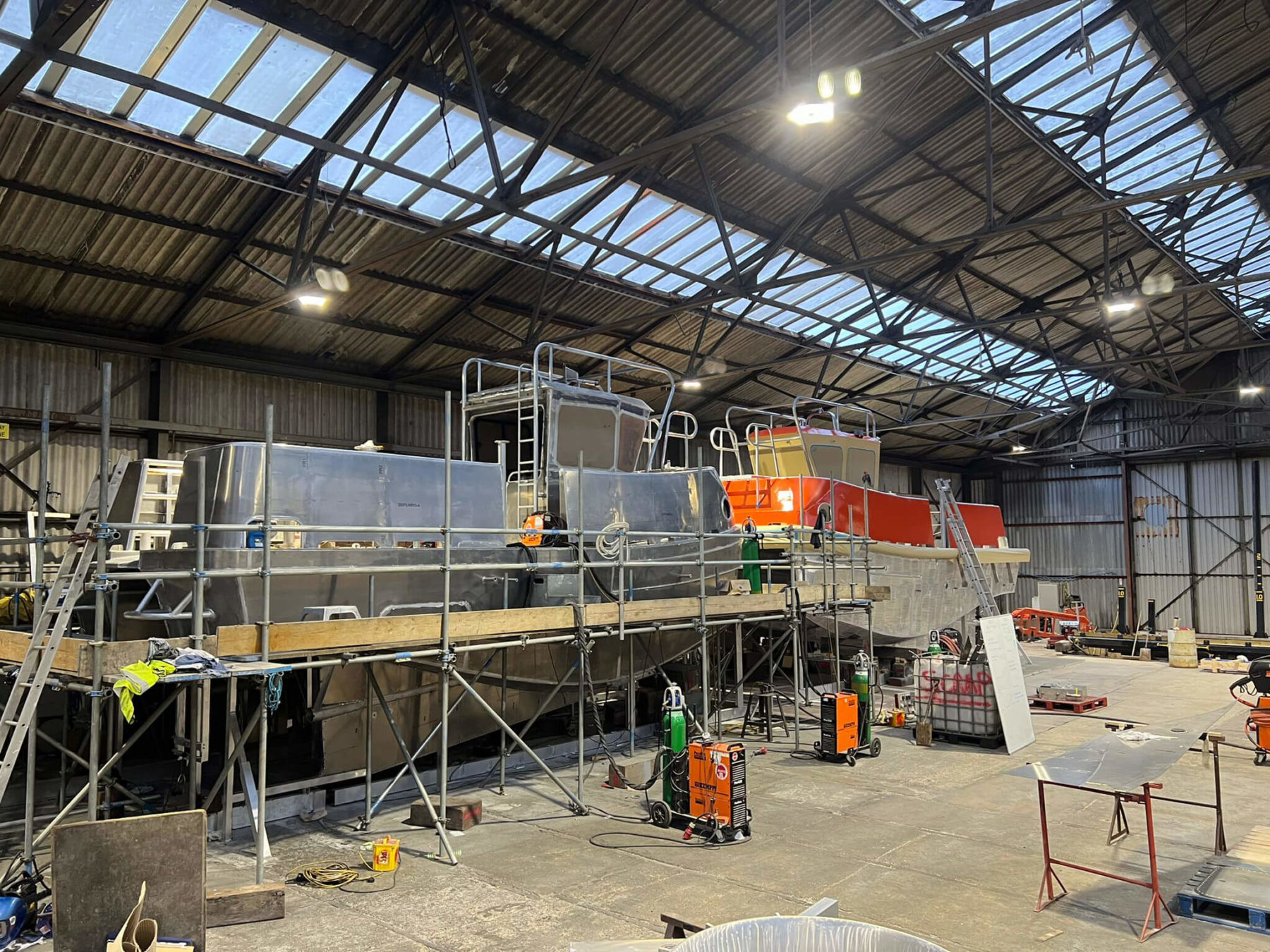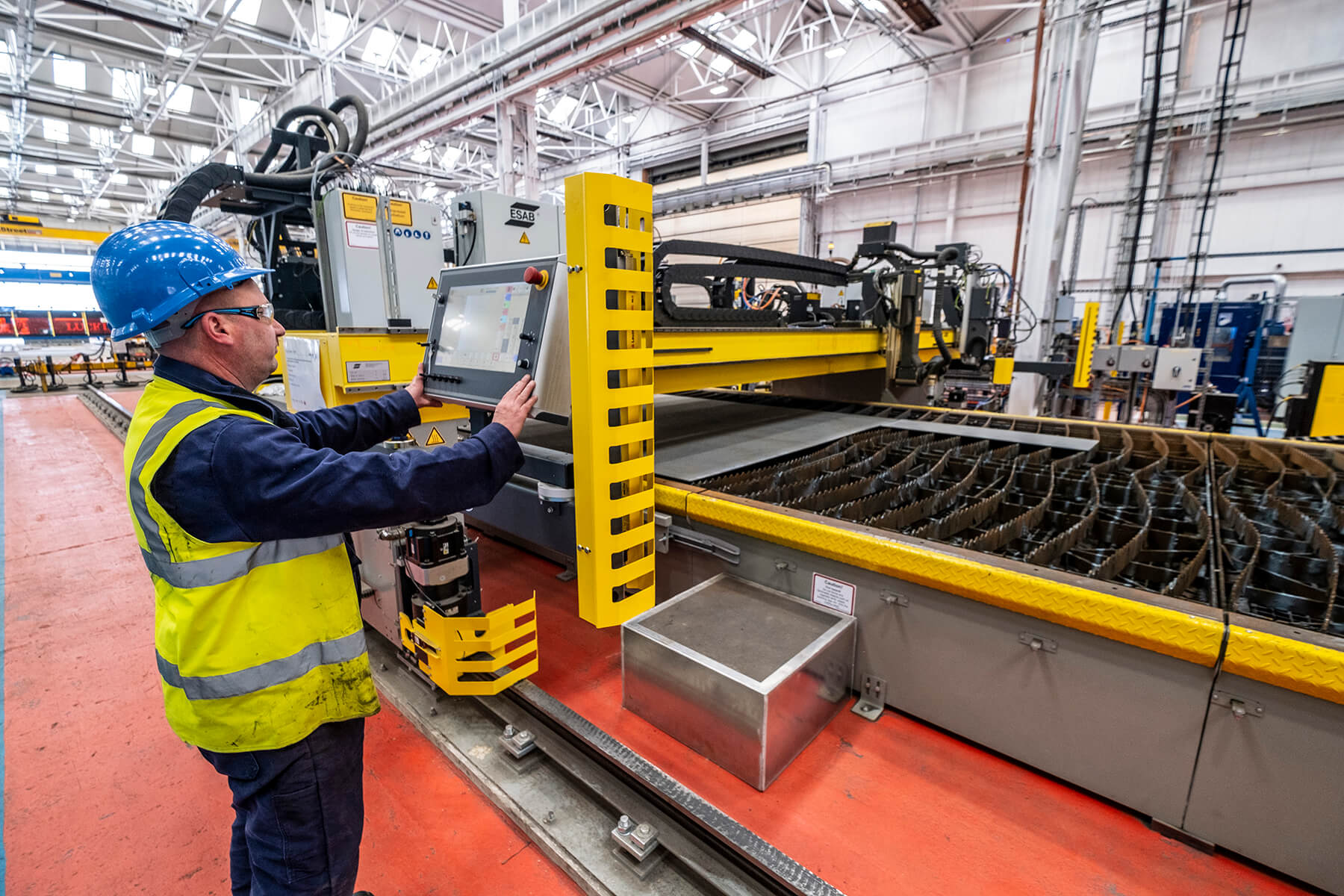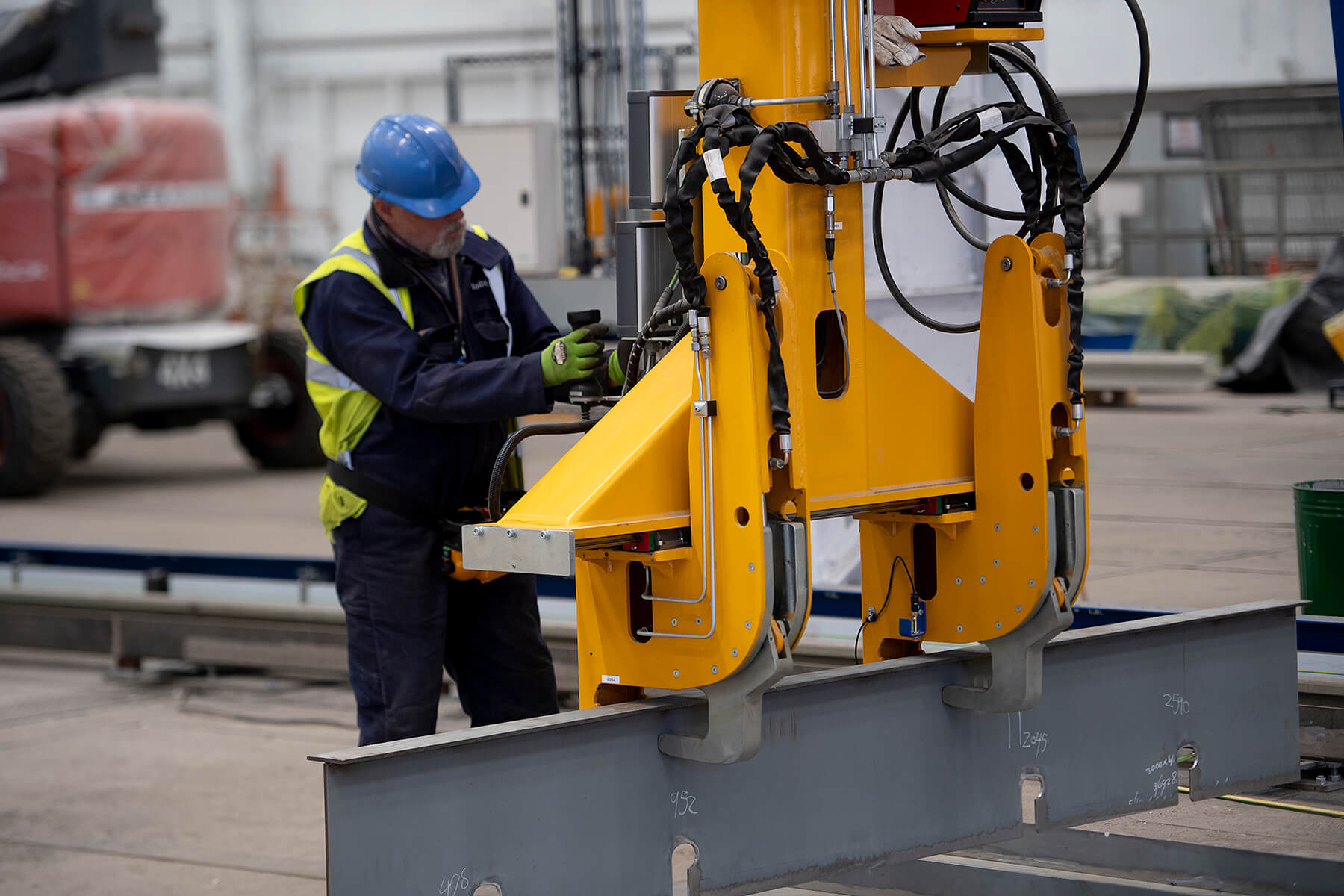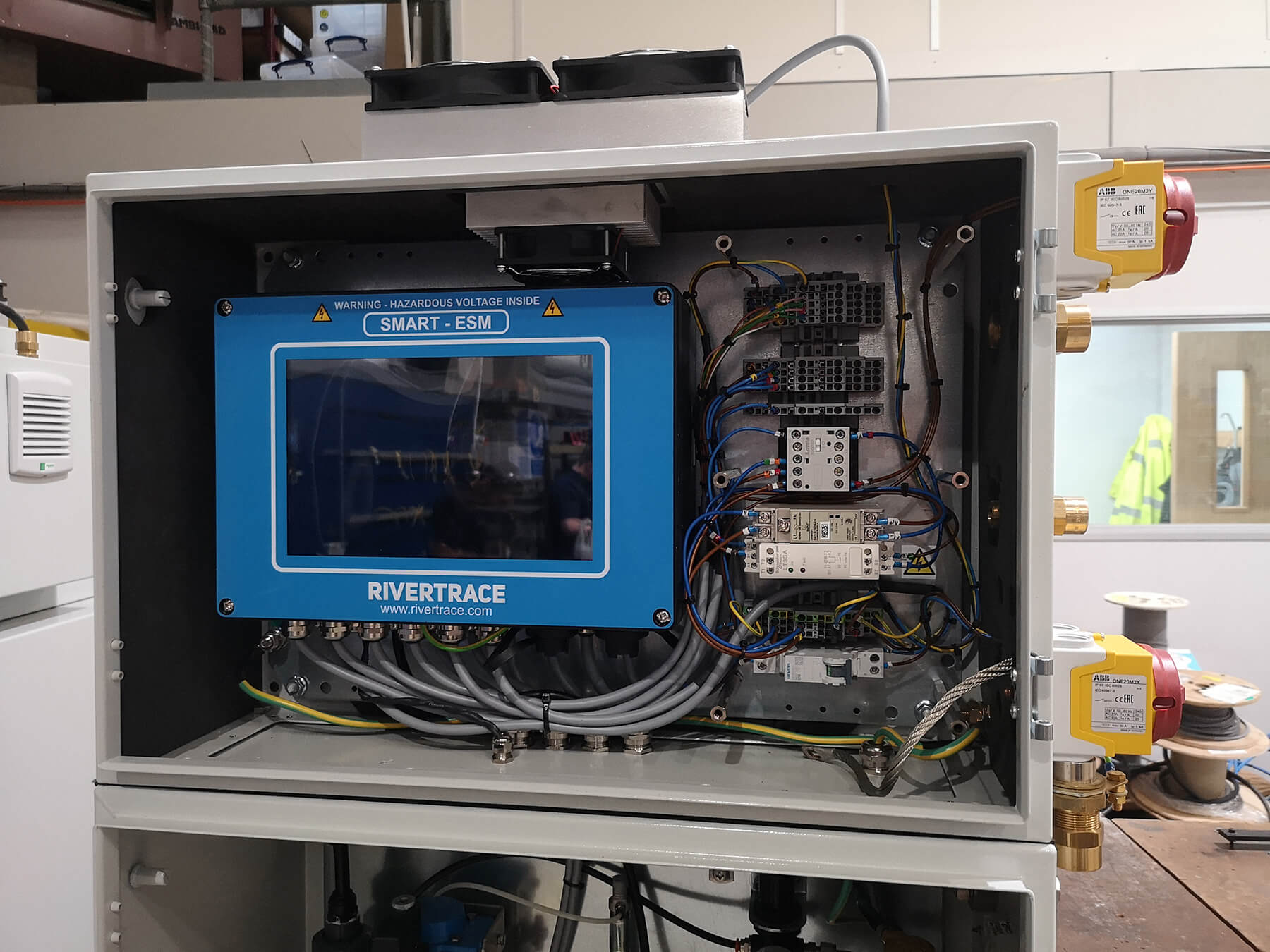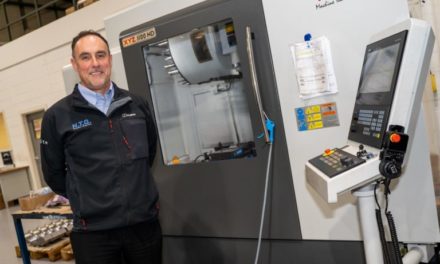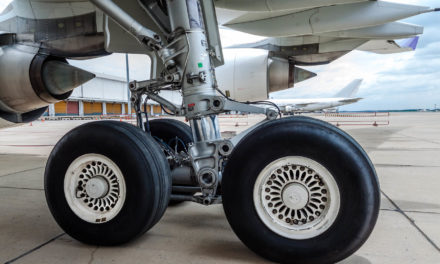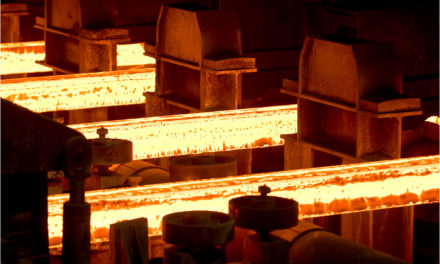Gearing up to Fulfill More Regular Demand
Sectors: Marine
Above: Forward and aft sections of HMS Glasgow being joined. Credit: BAE Systems
Investments in modernisation, an improved build process, and a new national strategy are helping move the UK’s marine industry out of choppy waters and into calmer seas. But there is still much work to be done if businesses wish to take full advantage of future opportunities.
Alan Tovey
Above: Vessels under construction at AMC’s shipyard in Cowes, Isle of Wight. Credit: AMC
There’s a new sense of confidence in Britain’s marine industry. In March, the Government set out its “refreshed” – but much-delayed – National Shipbuilding Strategy. It aims to bring consistency and regular orders to the sector, ending decades of damaging boom-and-bust cycles.
Unveiling the plan, prime minister Boris Johnson described shipbuilding as “being in the blood” of British industry, adding he wanted to “ensure it remains at the heart of British industry for generations”.
The strategy builds on a plan first laid out by veteran industrialist Sir John Parker in 2017. Sir John, a trained naval architect who held senior jobs at companies including Babcock, Harland & Wolff and Carnival, envisioned a “regular drumbeat” of orders for naval vessels.
The work would be shared across yards, with “blocks” of ships built around the country and transported to a central facility for assembly. He also wanted a new class of “budget” frigates with export potential, and the replacement of Navy ships at the end of their service lives, rather than costly extensions of clapped-out vessels.
Maintaining a critical mass
Parts of Sir John’s plan had already been implemented. Babcock is building five Type 31 frigates at its Rosyth yard. At £250m per hull, they are less than a third of the price of the more heavily specified Type 26s under construction by BAE Systems in Glasgow. Eight Type 26s are expected.
With regular orders on the horizon, Sir John aimed to end expensive ramping up and down of yards as contracts completed. This process discouraged investment in new technology and meant the loss of critical skills vital to sustaining the British marine sector. These skills not only trickle down from military shipbuilding into the commercial sector but also maintain a critical mass in the supply chain.
The refreshed strategy extends Sir John’s vision. Its headlines include a pledge to order 150 vessels ranging from warships to Border Force cutters to lighthouse ships over the next 30 years and £4bn of government funding to “galvanise and support” shipyards and suppliers. This includes access to funding, export aid, help with upskilling, and R&D into environmentally-friendly maritime technology.
Sir John says he is “encouraged” by the developments. “The industry needs visibility so it can invest,” he adds. “Without that, it just won’t happen.”
But it’s not just a state handout. The refreshed strategy refers to UK shipbuilding needing to boost productivity and competitiveness.
Sir John agrees; “We need much heavier investment in digital engineering, and as much automation as possible in fabrication facilities,” he says. “Utilising the power of digital engineering which can define every single nut and bolt to make blocks as complete as possible before assembly into a ship will make us more efficient.”
Investing in productivity
Babcock is one of the big winners out of Sir John’s original plan. The company’s chief corporate affairs officer, John Howie, has been heavily involved in the Type 31 and agrees the industry is now in a positive position.
“The refreshed strategy specifically set out to improve the UK industry’s productivity,” he says. “Productivity is fundamentally driven by investment and the ability to innovate and automate, as well as through skills.”
He says the Type 31 is the perfect example. Babcock pumped £76m into building a ‘frigate factory’ at its dockyard in Rosyth, Scotland.
“The Type 31 is a £250m vessel and a lot of people said it couldn’t be done for that price,” says Howie, who was previously Babcock’s Marine chief executive. “Well, we are doing it for that price but it’s on the back of £76m of investment in innovation in shipbuilding. That’s gone into things like the automated steel fabrication facility, which is world renowned.”
Babcock was part of the alliance that built the Navy’s Queen Elizabeth-class aircraft carriers, a process that used the “block-build” process championed by Sir John. Howie says the company learned from this.
“The carrier’s build was pretty efficient, but the Type 31 process is 200% to 300% better in some areas,” he says. “Yesterday, I was looking at an automated system that meant a complex pipework system that took 12 hours before was done in 11 minutes. That’s the kind of innovation we’re talking about.”
Such fantastic improvements came at a price: certainty.
“Investment is predicated by market certainty,” says the Babcock executive. “We were able to invest in Type 31 because we knew there were five ships coming, not a first in class, then one or two more, and maybe another couple. We could never justify the investment in Rosyth without that certainty.”
“Fundamental” modernisation
His views are echoed on the other side of Scotland, where BAE Systems is building the Type 26 frigates in its Glasgow yard.
Sir Simon Lister, a former admiral and now managing director of the company’s naval ships business, says: “We need continuity to build up and maintain the industry. There’s now a sense of commitment from government which gives the whole system a sense of the long-term. As we now know what’s coming in the order book we can plan.”
BAE has leveraged technology to make construction more efficient. A key example of this is the company’s digitalisation suite. Using this, engineers can virtually “fly” through a digital version of vessels. They can examine every pipe, nut, bolt, seeing how they fit together, with all items tracked. Problems are identified in a virtual world, rather than surfacing in real life, where problems are expensive to rectify.
Sir Simon describes it as a “fundamental” modernisation of shipbuilding, “from concept, to design, to manufacturing on the shop floor, which is increasing quality”.
He gives an example of how it is paying off. “I was inside HMS Glasgow [the first Type 26] talking to production leads scheduling compartment fit out. Using touchscreens, they could drill right down into how they were going to do things, examine issues from all angles and solve problems then and there.
“In the past, we might have made a one-third scale model out of plywood to practise outfitting. It’s technology like this that’s saving time and resource, and also means we can modify engineering in real-time.”
He adds that the technology is already transferring to the rest of the industry. “We’re building some of the most complex warships,” says Sir Simon. “But this is flowing into leisure and commercial vessels.”
Growth areas
As far south in the country from the Scottish yards as you get, Aluminium Marine Consultants (AMC) on the Isle of Wight is also riding the crest of a wave. The company which specialises in workboats – such as those servicing offshore wind turbines and fire tenders – is enjoying huge demand.
“We’ve got 80 staff and could do with another 20 tomorrow,” says commercial director Rob Stewart. He compares the company to “building from flat-pack kits, laser-cutting aluminium incredibly accurately and assembling it like a massive great jigsaw”.
A major driver is constructing vessels to service wind turbines, a huge growth area in the UK. This provides a foundation for the company, according to Stewart.
“It’s created an active home market, the
first time we’ve had that in a long time,”
he says. “You need that home market as something to hang your hat on, to build on to sell abroad.”
Helping the sector is patriotic demand. Stewart adds that AMC’s sister company Wight Shipyards is currently building two “Arksen” superyachts. These are designed as “explorer” luxury vessels capable of operating in the arctic.
“There’s a resurgence in English owners wanting British-built yachts or bringing them home for refit here,” says Stewart. “Whether that’s the marine engineering or fine joinery, it all feeds into demand here.”
Attracting future boat builders
Skills are crucial to the future of marine manufacturing. New talent needs to be attracted and equipped with the skills to be able to deliver the competitiveness the shipbuilding strategy demands.
“There are still more people who look like me in the industry than youngsters,” says Howie. “There’s a chance to change that, though. Graduates coming out of university are thinking about decarbonisation, and that’s an attraction of the marine sector. There are so many different technologies in marine looking at how that can be done. It’s an open landscape as we haven’t settled on a single answer.”
Whether this is electric power, hydrogen, clean synthetic fuels or even wind power, it means that marine is something of a clean sheet compared to many other sectors.
AMC is a prime example of the
chance near-limitless opportunities for those wishing to push the boundaries. The company has built unmanned vessels used for oceanography in distant oceans – “All remotely controlled from a base in Essex,” says Stewart – as well as working out how boats serving offshore wind turbines can
be powered by plugging into the devices
the maintain.
Playing to our strengths
Despite the hope, abandon ambitions that the UK can return to the dominance in
ship manufacturing it had more than a century ago. Huge yards in China and South Korea have sewn up the market for production of largely commoditised tankers, bulk carriers even cruise ships.
Instead, Britain can become a player in high-value, niche areas, such as British Antarctic Survey ship Sir David Attenborough, a vessel packed with technology and built by Cammell Laird.
Tom Chant, chief executive of the Society of Marine Industries has an upbeat – but realistic – view.
“The UK’s strong background in R&D puts us on the front foot,” he says. “We’re at the VHS/Betamax stage in the marine industry: we haven’t settled on the technology to use to decarbonise. There could be several, it all depends on the type of vessel, the speed, the length of the journey.
“But being at the early stage means there’s a chance for UK maritime engineering to be a much bigger part of the whole game and establish itself as a supplier of complex systems, rather than just a pipe here or valve there.”
Analogue people in a digital world
Also looking to the future is Mike Coomber, Managing Director of Rivertrace, a company with 60 staff based in landlocked Surrey producing sensors that detect oil in water, something vital in today’s environmentally aware shipping world.
As regulations toughen, the company’s devices – which can detect 0.1 parts of oil per million – are increasingly in demand.
Rivertrace is a poster child for what UK marine manufacturing can offer the world. “It’s a staggering statistic but we export 96% of our products, going to 65 countries,” says Mike.
The potential to do more is there, he says, but there are challenges. One is global, others domestic.
“Supply chains are a huge issue,” he says. “Covid was a breeze by comparison. We ordered semiconductors 56 weeks ago and they were due this month. We’ve now been told they are delayed for another five months and have been forced into the grey market for supplies, paying £30 instead of £3.”
His other worry is being able to build out on what he describes as the “world’s most innovative country. The biggest threat to manufacturing in the UK marine sector is that we are living in a digital world but employing analogue people. We need the highly skilled people who can weld, but that’s for the rectification of problems. Ask them to programme a machine that would do the welding automatically and you’re stuck.”
He predicts that without upskilling of a new generation of manufacturing engineers “we’ve got 10 to 15 years left or [British marine manufacturing] will be left behind”.
Sir Simon paints a similar picture. “There’s a romantic idea of shipbuilding being all steel work but the reality is that’s less than 10% of the effort of producing a ship,” he says. “Yes, the sparks and heat of welding are still
there but the bulk is the complex integration work – that’s why the skills portion really resonates.” l
Rising tide lifts all yachts
When it comes to the gleaming white hulls of gin palaces moored in idyllic coves, British motorboat builders Princess and Sunseeker leap to mind. The South Coast companies are the largest leisure craft producers in the country and global powers in the leisure boatbuilding sector.
But both suffered during the pandemic, reporting multimillion-pound operating losses in their last annual accounts as the Covid pandemic hit production. Now they are rebounding with the pandemic in their wakes.
Plymouth-based Princess, which employs 3,200 staff, is enjoying “record-setting performance” according to chairman and chief executive Antony Sheriff. Almost all of 2022’s production is covered by orders and more than 60% in the following year.
Poole-based Sunseeker is sitting on a £400m order book, a level described by the company as the “best in five or six years, possibly longer”.
News in Brief
- Green Fuels Research has successfully demonstrated the use of unblended sustainable marine fuel (SMF) refined from salmon farming waste at Eglwys Nunydd Reservoir near Port Talbot. Claimed to be a world first, the team behind the 100% renewable fuel says the product aids in the decarbonisation of UK shipping and provides sustainable management of animal by-product waste from UK aquaculture.
- Liverpool-based Marine Specialised Technology Group has undertaken a major expansion programme with the acquisition of a local River Mersey shipyard. The company, which manufactures and maintains high-speed boats for global defence and security markets, has embarked on a £1m refurbishment programme covering the entire 6.5-acre site, with further plans to create a centre of excellence in the North West for small craft design, manufacture and service.
- “The new larger facilities with its direct access to water now enables us to not only manufacture more craft at any one time but also to manufacture significantly larger vessels,” says sales director, Philip Hilbert. The new facilities will allow the company to significantly expand its operations including the ability to manufacture much larger craft
- US-headquartered marine antenna manufacturer, Shakespeare Marine, has begun manufacturing four of its best-selling VHF antennas at its factory in Lancashire.
- A pioneering new research centre exploring ‘maritime autonomy’ including smart ships and autonomous craft has launched at Warsash Maritime School, part of Solent University, Southampton. The Warsash Maritime Autonomous Surface Ships Research Centre will explore all aspects of maritime autonomy, from smart ships and smart ports to the human aspect of working alongside smart technology, including marine training and consulting.
“The industry needs visibility so it can invest”
Above and below: Babcock says automation has made some build processes up to 300% more efficient. Credit: Babcock
“The UK’s strong background in R&D puts us on the front foot”
Above: The Smartsafe ORB (oil record book) Bilge Overboard Security System was developed in response to global requests from customers. Credit: Rivertrace
Above: The SALMO (Sustainable Aquaculture Leading to Marine Opportunities) project was a collaboration between GFR, the University of Cardiff and Lancaster University. Credit: Green Fuel Research
Marine Specialised Technology Group’s new facilities will allow the company to significantly expand its operations including the ability to manufacture much larger craft. Credit: Marine Specialised Technology Group
Above: Sunseeker is sitting on a £400m order book. Credit: Trygve | stock.adobe.com

